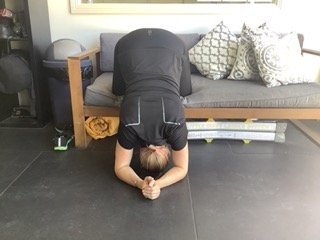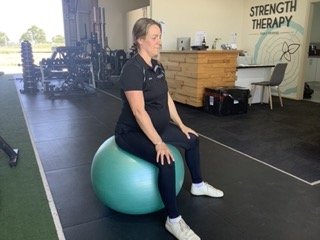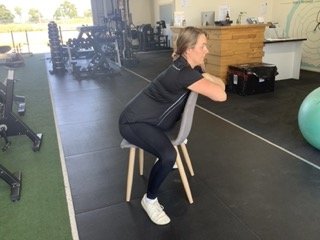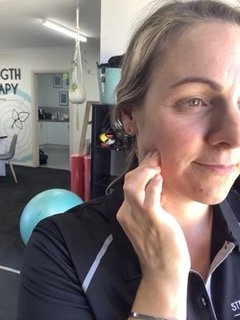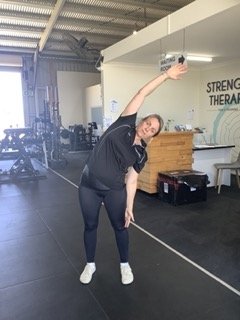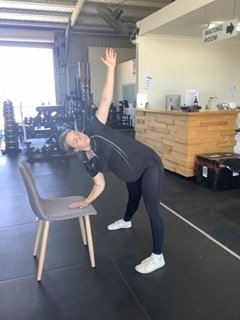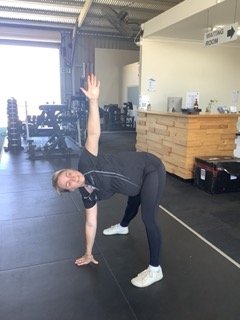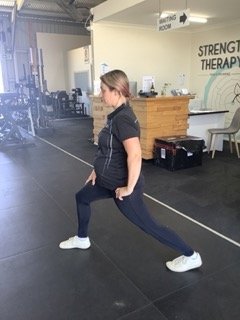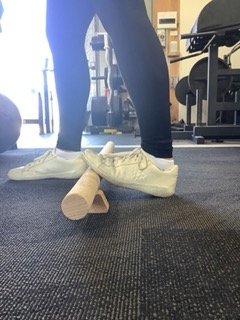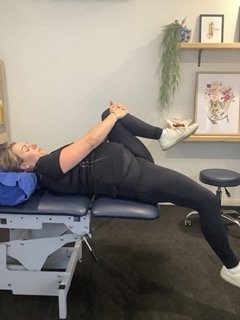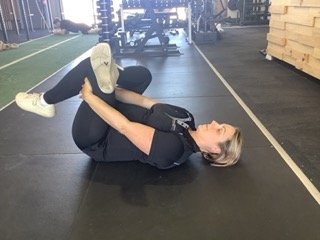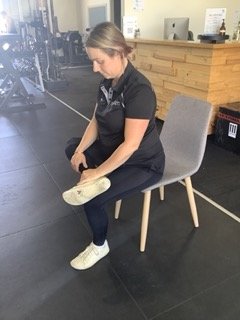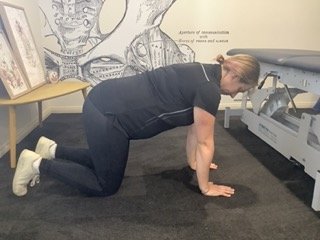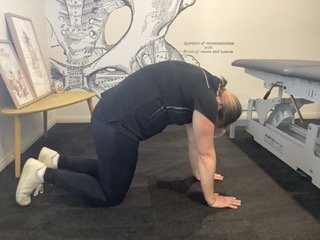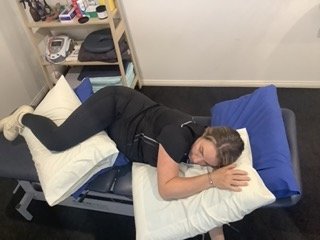Pregnancy exercises
Looking for comfort in pregnancy and a little easier birth? Use these daily exercises!
Many Physio’s, midwives and pregnancy practitioner’s will all agree that a more balanced, pain free, relaxed but optimal functioning body will feel more comfortable during pregnancy and may have an easier birth.
Let me walk you through them!
(**Please seek professional advice from your GP or health professional prior to undertaking or if any underlying medical issues.)
Activity 1
Walk everyday
Why? Walking briskly with a full range of motion lengthens our psoas muscles (hip flexors) and improves general health. This can help give us better range of motion and flexibility at the hips and back, improve foetal descent and positioning (when achieved with overall muscle balance & symmetry around the spine and pelvis).
Who does this? everyone who can.
How? Walk in safe place, with a pram or stopping to window shop. Walk at a pace you can hold a conversation.
How long? Start gradually and build it up to 4-5km daily (or at least 5 x week)
Don’t use this if… your provider has told you not to, such as your on best rest or are restricted movement for health reasons.
If you have pubic symphysis pain/pelvic girdle pain, wear a snug pregnancy belt (watch out for our next post for more info on this ;) ), and start slow. Or see your local Physio for stabilising exercises to restore control and reduce pain first and be guided by them to get back into walking.
Activity 2
Forward-Leaning Inversion
Why? The forward-leaning inversion potentially helps to create symmetry in the ligaments supporting the lower segment of the uterus and cervix (uterosacral, cervical, round ligaments). When you rise upright these ligaments relax, releasing any spasm that may be present, which allows babies head to fit more easily during labour.
Interestingly these ligaments, aren’t true ligaments, although they help to hold the uterus/cervix in place, they have small amounts of muscle fibres in them and are highly adaptable.
Who does this? All pregnant women without a contraindication – issues with blood pressure, especially high blood pressure. May make reflux worse if you’re susceptible.
How?
Kneel on the edge of a couch (or the top of the stairs). Kneel high to see what it feels like in your body.
Hold the edge of the couch, bed, or other surface you are kneeling on.
Carefully lower yourself to your hands on the floor and then lower yourself more to rest on your forearms. Keep your elbows out and hands close. Use a stool or step if you’d like, to help you walk your hands down.
Let your head hang freely, but keep your chin tucked. Don’t rest your head on the floor. Your neck may need a little movement. Straighten your shoulders to make room for your head.
Your knees should be close to the edge, and your bottom up high. You can tilt or sway your hips if you’d like, or gently, slowly undulate your spine.
You can flatten your lower back (posterior pelvic tilt) to make more room for the top of your pelvis.
Take three breaths. Loosen your belly but keep your shoulders strong. Tuck your chin and keep your neck long.
Come back up on your hands, then lift yourself up to a high kneeling position again using a stool, a block, or an assistant. Take two breaths here, then sit on your heels.
Swing your feet out from under you. Keep your feet together, moving like a mermaid to prevent a pull on your symphysis pubis (pubic bone) and protect your pelvic stability.
Do this once daily for 30 seconds (roughly three breaths).
Activity 3
Maternal Positioning
We recommend sitting with our:
Knees lower than the level of our hips
Belly lower than our hips – make sure your belly button points forward and down a little, not up.
Let your belly be a hammock for your baby
Sit on a kitchen chair – backwards!
When using an exercise ball make sure your hips are not lower than your knees!
Keep an upright back by sitting on the front of your sitz bones — not back on your sacrum
At a computer frequently? Get up hourly. Keep elbows and knees at a 45-degree angle and wrists floating above the keyboard.
Sitting on a firm ball will help your hips to stay fluid. Get up and move around frequently.
When you get in and out of the car, KEEP your knees and ankles CLOSE together. Swivel your hips to get your feet in and out of the car together. This will help prevent SI joint pain.
Activity 4
Stretch:
Each day, release tight muscles from your feet up and your head down. As above so below, so relax your jaw, loosen your neck and open your shoulders. Try these exercises!
1) TMJ ( tight jaw) release: clench your teeth and find the big muscles for chewing on the outside of your jaw. Pressure two fingers into the muscles and hold for a couple of minutes or 5 long deep breaths. Do this 2-3 times a day.
2) Neck rolls: make big, slow gentle circles with your head and stretch your neck, 20 or so each way.
3) Open your shoulders:
- Arm circles with side bend: Stand with feet apart and with your arms open wide, breathe in deep, exhale deeply, too. Inhale and lean over to your side, exhale and come back up. Repeat on the other side. Do a set of 5 in each direction.
- Arm swings: Brings arms out in front of you and gently swing them behind to touch. If you can’t touch yet, be consistent and you’ll get there.
- Clasp hands together behind your back: Don’t strain your shoulders, bring one hand over your shoulder, the other reaching up from behind to touch fingers. If this is too hard then use a towel or strap to bridge your hands. Repeat on each side.
4) Windmill:
- Stand with your feet apart. Broaden your shoulders. Raise the back of your head and let your buttocks free. Bend forward and put your palms on a chair seat in front of you, a stool, a yoga block, or the floor. Pick the height of one of these that best suits your back. You only go down as far as your back can stay straight. Look at both hands in front of you on your chosen surface. Now inhale and lift your right hand out to the side and up over your head. Follow your hand with your eyes by turning your head. It’s okay if your hips move, but when you return your hand to your surface during your exhale, your hips should end up straight and even. Now switch to your left hand.
- Raise your left hand by extending your arm out to your side and up over your head. Keep your hand in your vision by turning your head. Don’t move your hand further than you can see. Exhale and bring your hand back to the surface slowly. You will notice a slight tilt to your pelvis as you do this.
- Your legs are straight. Begin with 5-6 on each side. Work up to 10 on each side. This is so nice for your lower back and buttock muscles that you may find a week without windmills means an achy back or sciatica by the end of that week. So, keep this on your daily to-do list!
5) Forward lunge:
- One leg in front of the other, use support if needed for balance, and bend your front knee, feeling a stretch down the front of your back hip. Keep your body tall in this one.
6) Calf stretch:
- Place the ball of your foot onto a rolled-up towel, keeping your heel on the ground, take weight over the ball of your foot. Feel the stretch up the back of your lower leg and maybe back of your thigh. Bend and straighten the knee slightly to change the stretch. 10-20 x per side.
7) Squats:
- Feet hip width apart, or a little wider, with your feet in a comfortable position, sit your buttocks back and down, as if sitting on a chair. Go as low as you can without feeling unstable. Squeeze your buttocks to come back up. Repeat 5 x 10 daily. You can hold a stable surface or chair if you need some support.
Activity 5:
Psoas release
Why? A tight psoas muscle keeps baby high. Tightness can also affect, digestion, walking, balance and comfort.
Who does this? Yourself
How? Lie on your back on your bed or a massage table so that the bottom of your buttocks is at the very edge. Bring one of your thighs up at a 90-degree angle and hold it to your abdomen. After 2 1/2 to 3 minutes, change legs. Repeat. Roll to your side and get up slowly.
How long? 3 minutes each leg for 6 minutes total.
How frequent? Daily, or nearly so.
If you can’t lie on your back, then standing lunges or kneeling lunges will also do the trick
Activity 6:
Hip Openers/Glute stretches
Lying on your back, bring one ankle onto your opposite knee, reach your hand through the whole between your legs and around the upper thigh or knee of your leg that isn’t being stretched. Hold this position for 2 mins each side.
Do it daily or at least 3 x week
Again, if you cannot lie on your back, then use the sitting method. Same position, sitting in a chair, ankle onto top of thigh/knee, then keeping your body tall, lean forward from the hips/pelvis to feel the stretch in the back &/or side of your buttock.
Activity 7:
Pelvic Tilts
Why? Loosens hips and sacrum, relaxes lower back and builds awareness around movement at the pelvis.
Who? The mother
How? On hands and knees or leaning over a birth ball (fit ball). Start with your hands under your shoulders, knees under your hips. Knees are a little apart, not touching. Focus on your pelvis and lower back, lift your lower back, then flatten your back again. Like a cat/cow pose yoga pose.
How long? 20-40 pelvic tilts for comfort or about 2-3 minutes.
How frequent? Daily for comfort or about 20 mins in Labour.
Do this when… the lower back is tired or achy, or the hips are stiff. After balancing techniques to help baby swing to the anterior, or during labour through several contractions for the same aim.
Activity 8:
Rest SmartSM
Think of your belly as a hammock and let the baby lie with his or her back settling into the hammock. Don’t tuck your tail.
See picture below for a comfy position.
Change sides frequently for comfort and to help the uterus be a little more symmetrical.
Activity 9:
Relaxing what is tight in general
Other activities you might like to do and find helpful include:
- Prenatal Yoga or pregnancy exercise classes
- Swimming
- Hip circles on an exercise ball
- Pregnancy massage
- Physiotherapy for any pregnancy related or other musculoskeletal issues that limit your ability to do the above activities or cause pain/discomfort.
- Craniosacral therapy/Osteopathy
- Emotional resolutions: journaling, counselling, prayer, forgiveness, gratitudes.
I’m currently 28 weeks pregnant with our third baby and doing these exercises daily has helped tremendously in the quality of sleep and general comfort I feel day to day.
Give them a go, it may seem like a lot, but trust me, if you start then stop, you’ll miss them!
Cheers to comfort and an easier birth!
Bree :)
